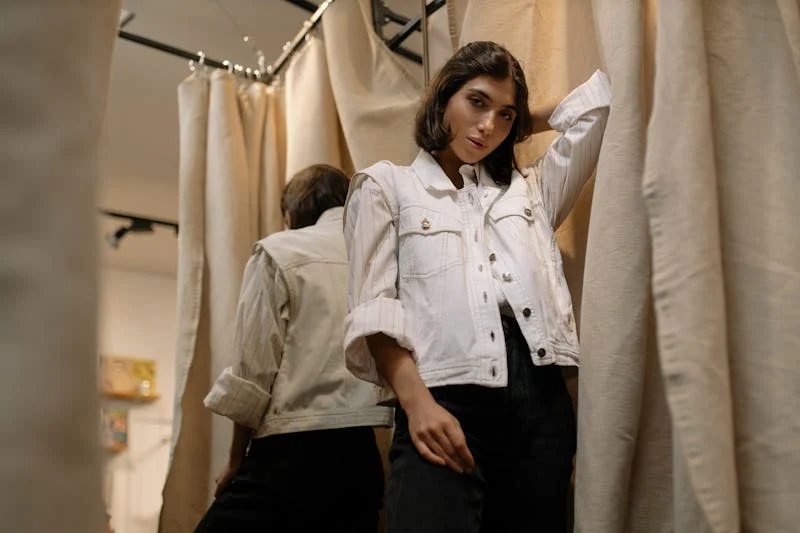
In today’s world, the conversation surrounding fashion is changing. More and more consumers are choosing to invest in eco-friendly, sustainable fashion, realizing that what we wear has a direct impact on the environment. With the rise of fast fashion, which contributes significantly to pollution, overconsumption, and labor exploitation, eco-friendly fashion offers a refreshing alternative. If you’re looking to make a difference without compromising on style, this article is for you. Here, we’ll explore the importance of eco-friendly fashion, the materials to look for, and the top pieces that will help you build a sustainable wardrobe that’s both fashionable and kind to the planet.
Why Choose Eco-Friendly Fashion?
Understanding the Importance of Sustainable Fashion
Fashion is a huge part of our identity. It tells the world who we are, what we believe in, and what we value. Yet, as we embrace fashion, we must also consider its impact on the environment. Fast fashion is responsible for significant pollution, waste, and exploitation, which is why eco-friendly fashion is not just a trend, but a necessity for the future of our planet. By choosing sustainable pieces, we can reduce waste, lower carbon emissions, and promote ethical labor practices.
The Environmental Impact of Fast Fashion
The rapid pace of fast fashion has made it easier than ever to buy cheap, trendy clothes. But this convenience comes at a cost. The fashion industry is one of the largest polluters in the world. It contributes to water pollution through toxic dyeing processes, emits millions of tons of CO2, and produces vast amounts of textile waste. Most fast fashion items are made with synthetic fabrics, like polyester, which take hundreds of years to break down in landfills.
Choosing eco-friendly fashion helps counteract these negative effects by promoting sustainable materials, ethical production practices, and slower, more mindful consumption.
What Does Eco-Friendly Fashion Mean?
Defining Eco-Friendly Fashion and What Makes It Sustainable
Eco-friendly fashion refers to clothing and accessories made with sustainable materials and ethical practices. This includes everything from the sourcing of raw materials to manufacturing processes and even packaging. Sustainable brands prioritize environmental conservation, fair wages, and safe working conditions.
But how do you identify truly eco-friendly fashion? Look for brands that use organic or recycled materials, have a transparent supply chain, and follow ethical labor practices. Certifications like Fair Trade, Global Organic Textile Standard (GOTS), and B Corp are indicators of a brand’s commitment to sustainability.
Key Characteristics of Eco-Friendly Fashion
- Materials: Eco-friendly brands use fabrics like organic cotton, hemp, and recycled polyester that are less harmful to the environment compared to conventional materials.
- Manufacturing: Ethical production processes ensure minimal waste, lower carbon emissions, and reduced water usage.
- Fair Trade Practices: Sustainable brands also focus on paying fair wages, ensuring workers’ safety, and supporting local communities.
The Role of Certifications
When shopping for eco-friendly fashion, it’s essential to look for certifications. These labels help ensure that brands adhere to ethical and sustainable standards. Key certifications to look for include:
- Fair Trade: Ensures workers receive fair wages and work in safe conditions.
- GOTS (Global Organic Textile Standard): Certifies that textiles are made from organic fibers and meet strict environmental and social criteria.
- B Corp: Recognizes companies that meet high standards of social and environmental performance, accountability, and transparency.
Sustainable Fabrics to Look For
Now that you understand the importance of eco-friendly fashion, let’s dive into the materials that make sustainable fashion possible.
Organic Cotton
Organic cotton is grown without the use of harmful pesticides or fertilizers. It uses less water than conventional cotton farming and supports healthier soil and ecosystems. It’s a soft, breathable fabric perfect for everything from t-shirts to dresses, and it’s far more eco-friendly than its conventional counterpart.
Recycled Polyester
Made from post-consumer plastic waste, such as discarded bottles, recycled polyester is an eco-friendly alternative to virgin polyester. By repurposing existing materials, it helps reduce waste and prevents plastic from ending up in landfills. Recycled polyester retains many of the qualities of regular polyester, such as durability and stretchability, making it ideal for activewear and outerwear.
Hemp and Bamboo
Hemp and bamboo are natural fibers that require minimal water and no pesticides to grow. They are incredibly durable, breathable, and biodegradable. Hemp is often used for casual clothing, while bamboo can be turned into soft, luxurious fabric that drapes beautifully, making it perfect for everything from tops to sleepwear.
Tencel and Lyocell
Tencel (or Lyocell) is a fabric made from wood pulp, typically sourced from sustainably managed forests. The production process uses a closed-loop system, meaning chemicals are recycled and reused, making it far less harmful to the environment compared to conventional rayon. Tencel is silky, soft, and biodegradable, making it a popular choice for both everyday wear and high-end fashion.
Top Eco-Friendly Fashion Pieces to Buy
Ready to update your wardrobe with sustainable options? Here are some eco-friendly pieces that combine style with sustainability:
Sustainable Dresses
Eco-friendly dresses made from organic cotton, hemp, or Tencel are stylish, comfortable, and perfect for any occasion. Look for brands like Reformation and People Tree that offer chic, sustainable dress options without sacrificing style.
Ethical Jeans
Sustainable denim is becoming more common, with brands like Levi’s and Everlane offering eco-conscious options. These brands use organic cotton, recycled polyester, and water-saving techniques to produce high-quality, stylish jeans.
Vegan Leather Bags
If you love leather bags but want to avoid animal products, look for vegan leather alternatives made from plant-based materials, such as Mushroom Leather or Pinatex (made from pineapple leaves). Brands like Matt & Nat and Stella McCartney offer beautiful, cruelty-free leather goods.
Eco-Friendly Shoes
Eco-friendly footwear brands like Allbirds and Veja use sustainable materials such as organic cotton, recycled plastic, and natural rubber. These shoes are stylish, durable, and environmentally friendly.
How to Build a Sustainable Wardrobe
Building a sustainable wardrobe doesn’t mean getting rid of everything you already own. It’s about making more conscious choices moving forward.
Start with Timeless Basics
Invest in high-quality, timeless pieces that will last for years. Think simple t-shirts, classic jackets, and versatile shoes. These items can be mixed and matched to create countless outfits without constantly buying new clothes.
Shop Secondhand and Vintage
Secondhand and vintage clothing is a fantastic way to reduce waste. Thrift stores and online platforms like Depop and ThredUp offer a wide variety of unique, pre-loved pieces that are still in great condition.
Avoid Trends and Focus on Quality
Trends come and go, but quality lasts. Instead of buying into every new fad, focus on building a wardrobe that reflects your personal style, with pieces that will stand the test of time.
Conclusion
Eco-friendly fashion is more than just a trend—it’s a movement towards a more sustainable, ethical, and conscious way of dressing. By choosing sustainable fabrics, supporting ethical brands, and building a wardrobe based on quality and longevity, you can make a significant impact on both the planet and your personal style. Sustainable fashion proves that you don’t have to sacrifice style for sustainability; in fact, it enhances it.

FAQs
- What makes a fashion piece eco-friendly? An eco-friendly fashion piece is made from sustainable materials, produced using ethical labor practices, and designed with minimal environmental impact.
- Are eco-friendly clothes more expensive? Eco-friendly clothes may have a higher upfront cost, but they often last longer, making them a better investment in the long run.
- What are some sustainable fabric alternatives to cotton? Hemp, bamboo, Tencel, and recycled polyester are all great eco-friendly alternatives to conventional cotton.
- How can I make my wardrobe more eco-friendly without spending a lot? Start by shopping secondhand, swapping clothes with friends, and focusing on buying high-quality, timeless pieces.
- Can I still follow fashion trends and be sustainable? Absolutely! Focus on incorporating sustainable versions of trendy items, such as eco-friendly dresses, vegan leather accessories, and recycled fabrics.





